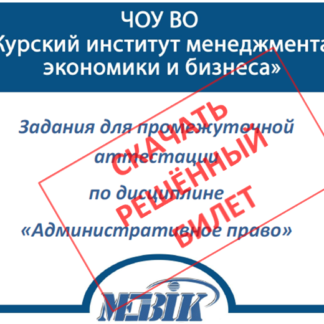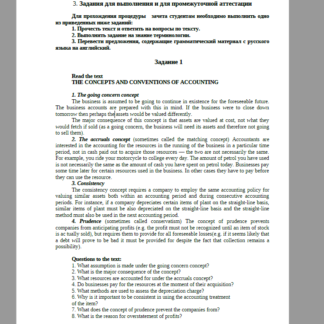Описание
Задание 1
Read the text
THE CONCEPTS AND CONVENTIONS OF ACCOUNTING
- The going concern concept
The business is assumed to be going to continue in existence for the foreseeable future.
The business accounts are prepared with this in mind. If the business were to close down tomorrow then perhaps the assets would be valued differently.
The major consequence of this concept is that assets are valued at cost, not what they would fetch if sold (as a going concern, the business will need its assets and therefore not going to sell them).
- The accruals concept (sometimes called the matching concept) Accountants are interested in the accounting for the resources in the running of the business in a particular time period, not in cash paid out to acquire those resources — the two are not necessarily the same.
For example, you ride your motorcycle to college every day. The amount of petrol you have used is not necessarily the same as the amount of cash you have spent on petrol today. Businesses pay some time later for certain resources used in the business. In other cases they have to pay before they can use the resource.
- Consistency
The consistency concept requires a company to employ the same accounting policy for valuing similar assets both within an accounting period and during consecutive accounting periods. For instance, if a company depreciates certain items of plant on the straight-line basis, similar items of plant must be also depreciated on the straight-line basis and the straight-line method must also be used in the next accounting period.
- Prudence (sometimes called conservatism) The concept of prudence prevents companies from anticipating profits (e.g. the profit must not be recognized until an item of stock is ac tually sold), but requires them to provide for all foreseeable losses(e.g. if it seems likely that a debt will prove to be bad it must be provided for despite the fact that collection remains a possibility).
Questions to the text:
- What assumption is made under the going concern concept?
- What is the major consequence of the concept?
- What resources are accounted for under the accruals concept?
- Do businesses pay for the resources at the moment of their acquisition?
- What methods are used to assess the depreciation charge?
- Why is it important to be consistent in using the accounting treatment of the item?
- What does the concept of prudence prevent the companies from?
- What is the reason for overstatement of profits?
Give English equivalents for:
комитет бухгалтерских стандартов
бухгалтерский отчет
основные принципы бухгалтерского учета
метод начисления амортизации основных активов
метод оценки запасов и незавершенного производcтва
учет и амортизация нематериальных активов
бухгалтерская политика
принцип непрерывности деятельности
оценить активы по себестоимости
принцип начисления
учет ресурсов
платить наличными
принцип постоянства правил бухгалтерского учета
бухгалтерская политика
принцип осмотрительности
возможные потери
Translate into English Using Passive Voice and Constructions with Non-Finite Forms of the Verb
- Оперативный учет используется для оперативного планирования и текущего управления. Его ведут там, где производится продукция предприятия и выполняются хозяйственные функции, то есть в цехах и службах. Данные оперативного учета используются внутри предприятия.
- На Западе используются также принципы оценки имущества и обязательств, двойной записи хозяйственных операций, осторожности, существенности, доброкачественности информации и др.
Методы оценки имущества и обязательств регламентированы не жестко, применяется метод «исторической оценки», т. е. оценки имущества и обязательств на дату совершения операции. Есть ряд способов перехода от «исторической оценки» к реальной.
Задание 2
Read the text
TYPES OF BUSINESS ENTITY
Features of sole traders and partnerships
A sole trader is exactly what it sounds- one person managing their own business. This person can employ as many workers as he wishes but does not share the finance, control, decision-making or profit with anyone else. This form of legal organization has unlimited liability. This means that there is no limit to the business debts for which the owner is responsible.
Responsibility extends to the possibility of having to sell private possessions to pay off the business debts. This form of organization is only simple for small, simple businesses with few employees and little capital.
A partnership is a way of sharing with others the managerial and financial responsibility for a business. Legally a partnership must consist of between 2 or 20 partners. Partnerships, like sole traders, usually have unlimited liability although limited partnerships are possible.
A partnership allows people to share capital and skills and expertise. More finance is available because all the partners can contribute. Although all the partners are responsible for the business’s debts, one partner is not liable for another’s private debts.
Vocabulary Notes
sole trader — компания в индивидуальной собственности
unlimited liability — неограниченная ответственность
business debt — долги компании
partnership — товарищество
managerial &financial responsibility — административная и финансовая ответственность
contribute — вносить
liable for private debts — ответственность за личные долги
Questions to the text:
What is the simplest form of business?
Does the owner have sole managerial and financial control?
Are profits shared?
To what limit does the responsibility of a sole trade extend?
What is a partnership?
What is a legal requirement for the number of partners?
Is unlimited liability of partners an advantage or disadvantage of a partnership?
What is the main difference between a sole trader and a partnership?
How do sole traders and partnerships differ?
Complete the text using the words:
Bankruptcy, creditors, issue, liability, losses, partnership, file, sole trader, financial, premises, capital, corporation
The simplest form of business is the individual proprietorship or (1) ………: for example, a shop or a taxi owned by a single person. If several individuals wish to go into business together they can form a (2) ………; partners generally contribute equal capital, have equal authority in management and share profits or (3) ……… In many countries, lawyers, doctors and accountants are not allowed to form companies, but only partnerships with unlimited (4) ……… for debts. But a partnership is not a legal entity separate from its owners; like sole traders, partners have unlimited liability: in case of (5) ………, a partner with a personal fortune can lose it all. Consequently, the majority of businesses are limited companies (US=(6) ………), in which investors are liable for the amount оf capital they have invested. If a limited company goes bankrupt, its assets are sold (liquidated) to pay the debts; if the assets do not cover the debts, they remain unpaid (i.e. (7) ……… do not get their money back.)
- Founders of companies have to write a Memorandum of Association (in the US, a Certificate of Incorporation), which states the company’s name, purpose, registered office or premises and authorized share (8) ……… (9) ……… (always with an ’s’ at the end)- is the technical term for the place in which a company does its business: an office, a shop, a workshop a factory , a warehouse, etc.
Authorized share capital means maximum amount, a particular type of share the company can (10) ……… Founders can write Articles of Association (US=Bylaws), which set out rights and duties of directors and different classes of shareholders. Companies’ memoranda and articles of association, and annual (11) ……… statements are sent to the register of the companies, where they may beinspected by the public. (A company that (12) ……… its financial statements late is almost certainly in trouble).
Translate into English Using Passive Voice and Constructions with Non-Finite Forms of the Verb
В денежных документах (например, приходных и расходных кассовых ордерах) исправления не допускаются.
Документы, поступившие в бухгалтерию, обязательно проверяют: по форме, устанавливают необходимое количество заполненных реквизитов, наличие подписей, четкость заполнения документа. Затем проводится арифметическая проверка: определяют правильность подсчетов. Далее проверяют документ по существу: проверяют законность хозяйственной операции.
После этих проверок документы подвергают бухгалтерской обработке, под которой понимают их расценку, группировку и разметку.
Задание 3
Read the text
PROFIT AND LOSS ACCOUNT
Companies are required by law to give shareholders certain financial information. Most companies include three financial statements in their annual reports. The profit and loss account shows revenue and expenditure. It is one of the statutory accounts, which, for most limited companies, has to be filed with the UK Register of Companies. The profit and loss account usually consists of three parts.
The first is a trading account, showing the total sales income less the cost of production, etc., and changes in the value of stock or work in progress from the last accounting period. This gives the gross profit (or loss). The second part gives any other income (apart from trading) and lists administrative and other costs to arrive at a net profit (or loss). From this net profit before taxation the appropriate net tax is deducted to give the net profit after taxation. In the third part, the net profit after tax is appropriated to dividends and reserves.
Questions on the text:
What are companies required to do by law?
What financial data does profit and loss account show?
How is profit after taxation calculated?
How is profit of the company used?
Task I Give the English for:
предоставлять финансовую информацию акционерам
компании
финансовые отчеты
отчет о прибылях и убытках
расходы и доходы
товарооборот
распределять прибыль
нераспределенная прибыль
выплачивать долги
валовая прибыль
доход от акций в ассоциированных компаниях
доход от инвестиций в основные активы
прибыль от обычной деятельности до взимания налогов
Fill in the missing words in the sentences below. Choose from the following:
-administrative expenses — distribution — dividend — extraordinary — ordinary —operating
As A Z. Ltd is a small printing company, all their printing contracts are known as ……… activities.
Recently a firm company paid A.Z. Designs a large amount of money to use the company premises when making a film. This was recorded in the P&L account as ……… item.
Income, which the company makes in its normal activities, is known as ……… .
At the end of the year, some of the profits may be shared out among the shareholders who will receive a ……… .
The costs of getting the goods to the customers are shown as ……… .
The secretary’s salary and expenses incurred in the office are shown as…. .
Translate into English Using Passive Voice and Constructions with Non-Finite Forms of the Verb
Записать хозяйственную операцию на счетах означает отразить ее содержание в бухгалтерских книгах, карточках или свободных листах, являющихся учетными регистрами. Форма регистров зависит от особенностей учитываемых объектов, назначения регистров, способов учетной регистрации, под которой понимается запись хозяйственных операций в учетных регистрах.
Требование к записям в учетных регистрах – они должны быть краткими, четкими, разборчивыми. После регистрации хозяйственной операции в учетном регистре на бухгалтерской проводке или на самом первичном документе делают соответствующую отметку для облегчения последующей проверки правильности разноски. Надо учитывать, что содержание регистров бухгалтерского учета и внутренней бухгалтерской отчетности является коммерческой тайной.




